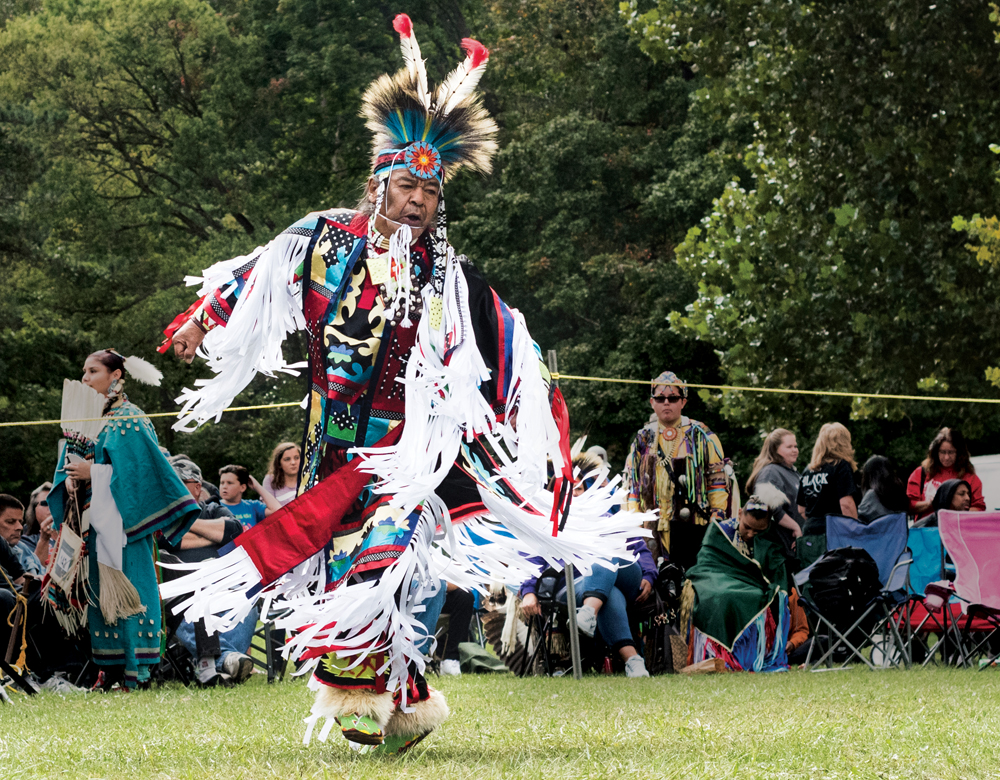
On the first day of fall, with the air crisp and the sound of drums thundering, a crowd gathers in Westland. They meet in Nankin Mills park where, not too far away a few centuries ago, tribes native to the Great Lakes region т The Anishinaabe or Three Fires people, which includes the Ojibwe, Odawa, and Potawatomi т likely met to trade goods and hold meetings. Today, itтs the location for the Native American Indian Association of Detroitтs 14th annual Native American Heritage Day Pow-Wow, a gathering where traditions are passed down through song, dance, artisan crafts, and more. тThe center of everything is knowing who you are and where you come from,т says Brian Moore, executive director of NAIA and emcee for the event. тArt is that expression of lived experiences.т
Ranging in age, gender, and background, dancers dress in Native regalia, which includes colorful shields, rattles, breastplates, and headdresses, preparing to compete against each other. The resonant sounds of drum beats and high vocals, a combination of melodic chants and Native American words from Anishinaabe and Mohawk languages, become one with the air as the introductory procession, known as the Grand Entry, begins. Drum circle members hailing from Detroit; Athens, near Battle Creek; and London, Ontario; gather at the perimeter as dancers tap their feet and feathers sway above their heads.

Reg Pettibone, a champion pow-wow dancer from the Ho-Chunk Nation of Wisconsin, is performing the Grass Dance in the Menтs Golden Age competition today. In his fringed regalia, Pettiboneтs footwork is swift and fast-paced. His movements are symmetrical as he sweeps in place, imitating the long prairie grass on which buffalo roam. The dance symbolizes respect for the land, animals, and the circle of life, Pettibone says. At the same time, the dance, which dates back to the 19th century, blesses the ground at gatherings like pow-wows. As Pettibone shares, itтs a tradition that lives on in these gatherings, despite attempts at cultural erasure by the U.S. government, such as the Indian Removal Act of 1830, a law signed by President Andrew Jackson that resulted in a forced migration where more than 4,000 Cherokee people died. тOur songs and dance are a way of life,т he says.
Pettibone, who is now a Livonia resident, frequently performs at pow-wows, universities, schools, and museums across the country. At 64, he still vividly remembers the first years of his life in a reservation near Black River Falls in Wisconsin, with the light of kerosene lamps flickering and the sounds of an AM radio buzzing. He recalls that when sunset occurred, his grandfather, uncles, and even neighbors gathered around with drums in tow to start singing. This is where dance became a passion. тI started whenever I could hold a beat,т Pettibone says. тIt couldтve been when I started walking at 7 months old.т
In many ways, in Native American culture, the art of dance and music started at the cusp of creation, as Pettibone explains. During the base, or the first two steps of all dances, the movement of the left foot represents the human leaving the Creatorтs side after their inception, and traveling through the heavens. The movement of the right foot symbolizes reaching Earth. тWhen the right foot was placed on Mother Earth, the human being was overjoyed. He continued to express thanks through dance,т Pettibone says. тThis is why, as human beings, when we dance, itтs an expression of gratitude for all the gifts that we receive т food, clothing, shelter, medicine.т
тArt is that expression of lived experiences.т
т Brian Moore, Executive Director of NAIA
Pettibone says because these dances were here from the moment humans stepped foot on Earth, it only makes sense that they continue as generations go on. тDance is a part of the circle of life,т he says. тFamilies have kept them through the hard times theyтve gone through when the government called [our traditions] war dances, war songs, and war drums.т Pettibone is pleased to see more families participating in gatherings, dancing, and upholding traditions. He shares that Native dance and song evokes a respect for the Earth that is important to pass along. Preserving and sharing culture is a practice the NAIA advocates for as well. The association organizes cultural activities and events across metro Detroit, to educate other communities about Native American history and to help its youth celebrate their traditions. тCultural identity is one of the most important things that we have right now,т executive director Moore says. However, culture is not only celebrated through gatherings like pow-wows. Today, Native American artists are honoring their roots through a multitude of mediums.
In Detroit, young artists, like Sacramento Knoxx and Giizhigad of The Aadizookaan or ADZKN, are upholding traditional elements through a modern lens. ADZKN, which translates to тthe sacred spirit of story,т is a multi-media arts organization that is made up of 12 members who specialize in music, film, design, and storytelling. Together, they perform and curate projects rooted in the knowledge systems of Detroitтs first people, the Anishinaabe. The members of the group are working to carve a home for Native American artists, and theyтre drawing inspiration from the land on which they tread to share stories. тWhen Native people are seen and observed, itтs like weтre stuck in a certain time zone,т says Knoxx, an Anishinaabe and Chicano rapper and filmmaker. тWeтre doing what our ancestors did long ago, but in a contemporary setting. Itтs the same idea of telling and carrying story in our community so our people can grow, vibe, learn, and process.т

Giizhigad, whose name means тdayт in the Ojibwe language, is an AnishinaabeЬ§artist and cultural worker. Originally from the Washington, D.C. area, she says her journey brought her to Michigan because тthese are my homelands and where my people are from.т She dances Fancy Shawl, a fairly new dance style that is inspired by butterflies emerging from their cocoon. Giigzhigad, also a bead artist who has created dream catchers since she was young, is working on preserving Anishinaabemowin, the language of the Anishinaabe people т the Ojibwe, the Oadawa, and the Pottawatomi т that is in danger of becoming extinct. тI think that our language is artistic in the way that all of the words are stories, which relate to the relationship with land,т she says. For example, the wordЬ§ тjiimaanт translates to тcanoe.т It means kiss, and it reflects how a canoe connects with the water. тEven after we build something, weтre looking at how itтs interacting with the land and weтre giving honor to those pieces [through language].тAlthough ADZKN members are sometimes performing in more contemporary spaces and mediums than their ancestors, it doesnтt make their work any less traditional. Perhaps reminiscent of the pow-wows, Giizhigad says that when she and Knoxx dance at the end of their performances, theyтre тtaking something that is a traditional value of dancing together to connect.т She says a large part of being a Native American artist is recognizing the power of indigeneity, and understanding that it wasnтt ever lost or decimated. In fact, by working together in community, all of ADZKNтs members can continue to pass down the traditions started by their ancestors. тI have learned so much from being [in Detroit],т Giizhigad says. тThereтs a beautiful thing that can come from the roots that are still in the ground.т
|
| Ь§ |
|








